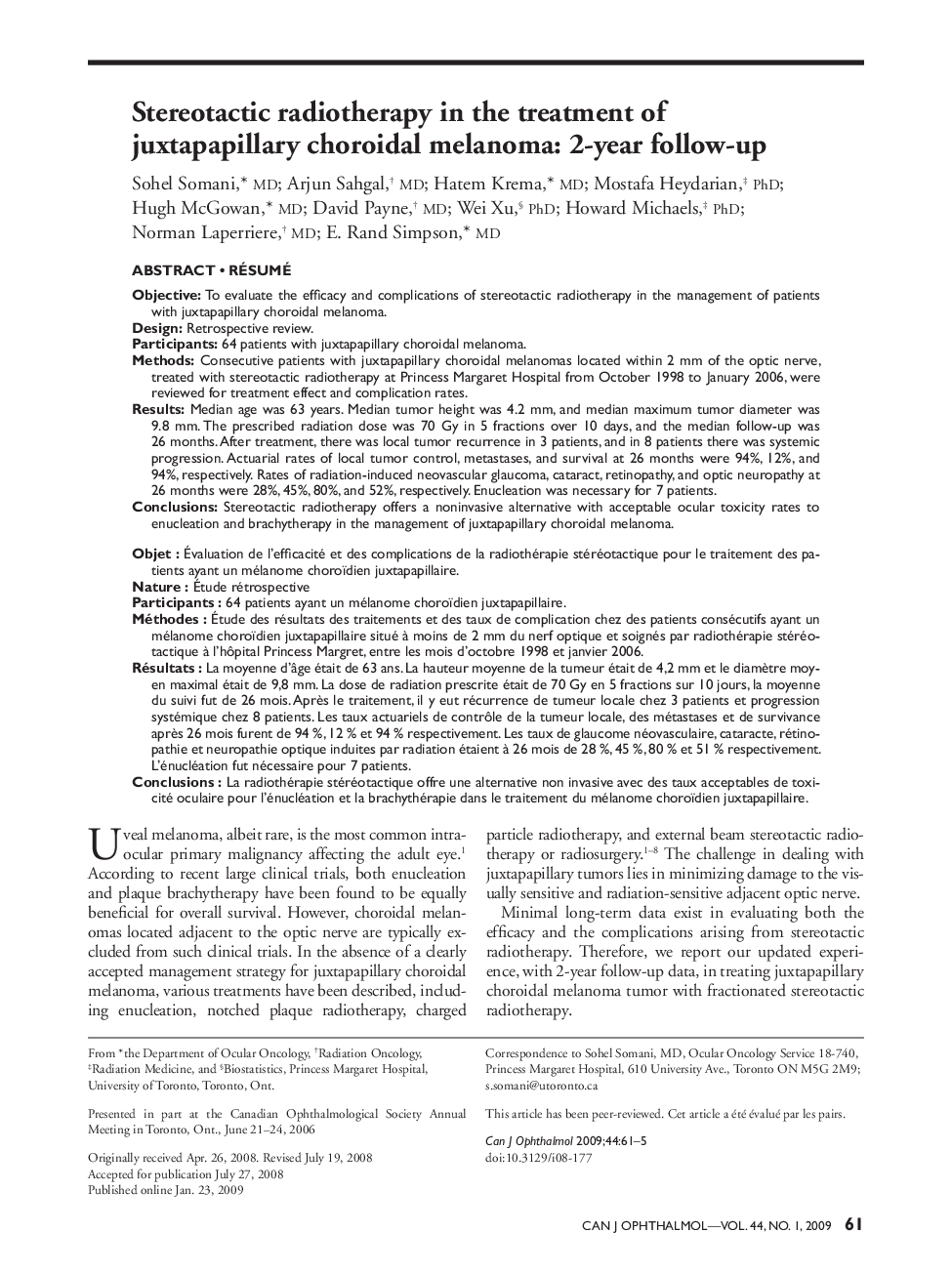| Article ID | Journal | Published Year | Pages | File Type |
|---|---|---|---|---|
| 4010325 | Canadian Journal of Ophthalmology / Journal Canadien d'Ophtalmologie | 2009 | 5 Pages |
Objective: To evaluate the efficacy and complications of stereotactic radiotherapy in the management of patients with juxtapapillary choroidal melanoma.Design: Retrospective review.Participants: 64 patients with juxtapapillary choroidal melanoma.Methods: Consecutive patients with juxtapapillary choroidal melanomas located within 2 mm of the optic nerve, treated with stereotactic radiotherapy at Princess Margaret Hospital from October 1998 to January 2006, were reviewed for treatment effect and complication rates.Results: Median age was 63 years. Median tumor height was 4.2 mm, and median maximum tumor diameter was 9.8 mm. The prescribed radiation dose was 70 Gy in 5 fractions over 10 days, and the median follow-up was 26 months. After treatment, there was local tumor recurrence in 3 patients, and in 8 patients there was systemic progression. Actuarial rates of local tumor control, metastases, and survival at 26 months were 94%, 12%, and 94%, respectively. Rates of radiation-induced neovascular glaucoma, cataract, retinopathy, and optic neuropathy at 26 months were 28%, 45%, 80%, and 52%, respectively. Enucleation was necessary for 7 patients.Conclusions: Stereotactic radiotherapy offers a noninvasive alternative with acceptable ocular toxicity rates to enucleation and brachytherapy in the management of juxtapapillary choroidal melanoma.
RésuméObjet: Évaluation de l’efficacité et des complications de la radiothérapie stéréotactique pour le traitement des patients ayant un mélanome choroïdien juxtapapillaire.Nature: Étude rétrospectiveParticipants: 64 patients ayant un mélanome choroïdien juxtapapillaire.Méthodes: Étude des résultats des traitements et des taux de complication chez des patients consécutifs ayant un mélanome choroïdien juxtapapillaire situé à moins de 2 mm du nerf optique et soignés par radiothérapie stéréotactique à l’hôpital Princess Margret, entre les mois d’octobre 1998 et janvier 2006.Résultats: La moyenne d’âge était de 63 ans. La hauteur moyenne de la tumeur était de 4,2 mm et le diamètre moyen maximal était de 9,8 mm. La dose de radiation prescrite était de 70 Gy en 5 fractions sur 10 jours, la moyenne du suivi fut de 26 mois. Après le traitement, il y eut récurrence de tumeur locale chez 3 patients et progression systémique chez 8 patients. Les taux actuariels de contrôle de la tumeur locale, des métastases et de survivance après 26 mois furent de 94%, 12% et 94% respectivement. Les taux de glaucome néovasculaire, cataracte, rétinopathie et neuropathie optique induites par radiation étaient à 26 mois de 28%, 45%, 80% et 51% respectivement. L’énucléation fut nécessaire pour 7 patients.Conclusions: La radiothérapie stéréotactique offre une alternative non invasive avec des taux acceptables de toxicité oculaire pour l’énucléation et la brachythérapie dans le traitement du mélanome choroïdien juxtapapillaire.
